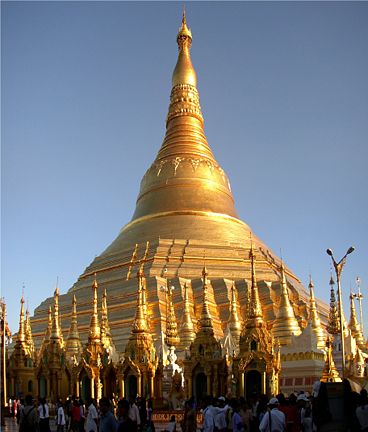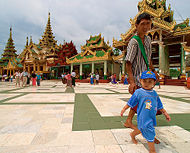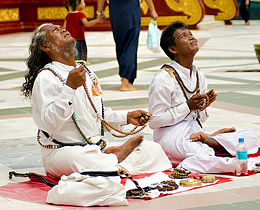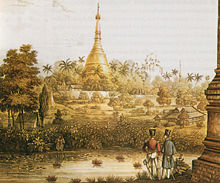Shwedagon Pagoda
| Shwedagon Pagoda | |

Shwedagon Pagoda brights up in gold and is often visited for its grand scale |
|
| Information | |
|---|---|
| Location | Yangon, Myanmar |
| Status | Complete |
| Constructed | 6th century |
| Use | Pilgrim, and missionary of Buddhism |
| Height | |
| Antenna/Spire | 112.17 metres (368 ft) |
| Roof | 105 metres (344 ft) |
| Companies | |
| Architect | King Okkalapa |
The Shwedagon Pagoda (IPA: [ʃwèdəgòun]; Burmese: ![]() ; MLCTS: hrwe ti. gum. bhu. ra:; IPA: [ʃwèdəgòun pʰəjá]), officially titled Shwedagon Zedi Daw (IPA: [ʃwèdəgòun zèdìdɔ̀]), also known as the Golden Pagoda, is a 98-metre (approx. 321.5 feet) gilded stupa located in Yangon, Burma. The pagoda lies to the west of Kandawgyi Lake, on Singuttara Hill, thus dominating the skyline of the city. It is the most sacred Buddhist pagoda for the Burmese with relics of the past four Buddhas enshrined within, namely the staff of Kakusandha, the water filter of Konagamana, a piece of the robe of Kassapa and eight hairs of Gautama, the historical Buddha.
; MLCTS: hrwe ti. gum. bhu. ra:; IPA: [ʃwèdəgòun pʰəjá]), officially titled Shwedagon Zedi Daw (IPA: [ʃwèdəgòun zèdìdɔ̀]), also known as the Golden Pagoda, is a 98-metre (approx. 321.5 feet) gilded stupa located in Yangon, Burma. The pagoda lies to the west of Kandawgyi Lake, on Singuttara Hill, thus dominating the skyline of the city. It is the most sacred Buddhist pagoda for the Burmese with relics of the past four Buddhas enshrined within, namely the staff of Kakusandha, the water filter of Konagamana, a piece of the robe of Kassapa and eight hairs of Gautama, the historical Buddha.
Contents |
History
According to legend, the Shwedagon Pagoda is 2500 years old. Archaeologists believe the stupa was actually built sometime between the 6th and 10th centuries by the Mon, but this is a very controversial issue because according to the records by Buddhist monks it was built before Lord Buddha died in 486 BC. The story of Shwedagon Pagoda begins with two merchant brothers, Taphussa and Bhallika, from the land of Ramanya, meeting the Lord Gautama Buddha and receiving eight of the Buddha's hairs to be enshrined in Burma. The two brothers made their way to Burma and with the help of the local king, King Okkalapa, found Singuttara Hill, where relics of other Buddhas preceding Gautama Buddha had been enshrined. When the hairs were taken from their golden casket to be enshrined some incredible things happened:

| “ | There was a tumult among men and spirits ... rays emitted by the Hairs penetrated up to the heavens above and down to hell ... the blind beheld objects ... the deaf heard sounds ... the dumb spoke distinctly ... the earth quaked ... the winds of the ocean blew ... Mount Meru shook ... lightning flashed ... gems rained down until they were knee deep ... all trees of the Himalayas, though not in season, bore blossoms and fruit. | ” |
The stupa fell into disrepair until the 1300s when the Mon king Binnya U of Bago had the stupa rebuilt to a height of 18 meters (60 ft). It was rebuilt several times and reached its current height of 98 meters (320 ft) in the 15th century. The Mon kingdom possessed two great pagodas of especial sanctity, the Shwemawdaw at Bago and the Shwedagon. Originally only twenty-seven feet high, it was raised to a height of sixty-six feet in 1362 by King Binnya U as an act of special piety. Dhammazedi's immediate predecessor, his mother-in-law Queen Shinsawbu (1453-72), raised its height to 40 meters (129 ft). She terraced the hill on which it stands, paved the top terrace with flagstones, and assigned land and hereditary slaves for its maintenance. When in 1472 she yielded up the throne to Dhammazedi, she retired to Dagon, and during her last illness had her bed placed so that she could rest her dying eyes upon the gilded dome of the sacred fane. The Mon face of the Shwe Dagon inscription catalogues a list of repairs beginning in 1436 and finishing during Dhammazedi's reign. It mentions Queen Shinsawbu under a terrific Pali name of sixty-six letters. By the beginning of the sixteenth century the pagoda had become the most famous place of pilgrimage in Burma. [1]
A series of earthquakes during the next centuries caused damage. The worst damage came from a 1768 earthquake that brought down the top of the stupa and it was raised to its current state by King Hsinbyushin (lit. Lord of the White Elephant) of Konbaung Dynasty. A new hti or crown was donated by King Mindon Min in 1871 after the annexation of Lower Burma by the British.
An earthquake of moderate intensity in October 1970 put the shaft of the hti visibly out of alignment. A scaffold was erected and extensive repairs to the hti were made.

Design
There are four entrances (mouk) to the Paya that lead up a flight of steps to the platform (yin byin) on Singuttara Hill. The eastern and southern approaches have vendors selling books, good luck charms, Buddha images, candles, gold leaf, incense sticks, prayer flags, streamers, miniature umbrellas and flowers. A pair of giant chinthe (leogryphs, mythical lions) guard the entrances and the image in the shrine at the top of the steps from the south is that of the second Buddha, Konagamana. The base or plinth of the stupa is made of bricks covered with gold plates. Above the base are terraces (pyissayan) that only monks and men can access. Next is the bell-shaped part (khaung laung bon) of the stupa. Above that is the turban (baung yit), then the inverted almsbowl (thabeik), inverted and upright lotus petals (kya hmauk kya hlan), the banana bud (nga pyaw bu) and then the crown. The crown or umbrella (hti) is tipped with 5,448 diamonds and 2,317 rubies. The very top, the diamond bud (sein bu) is tipped with a 76 carat (15 g) diamond.
The Gold seen on the stupa is made of genuine gold plates, covering the brick structure attached by traditional rivets. Myanmar people all over the country, as well as monarchs in its history,have donated gold to the pagoda to maintain it. It was started in the 15th century by the Mon Queen Shin Sawbu who gave her weight in gold and continues to this day.
Rituals

Visitors must remove their shoes before the first step at any of the entrances. The southern and eastern approaches have traditional shops with wide gradual staircases. In addition these entrances have an elevator and the infrequently used western one is equipped with escalators. Burmese walk around the stupa clockwise (let ya yit). The day of the week a person is born will determine their planetary post, eight in all as Wednesday is split in two, a.m. and p.m. They are marked by animals that represent the day, galon (garuda) for Sunday (ta nin ganway), tiger for Monday (ta nin la), lion for Tuesday (in ga), tusked elephant for Wednesday a.m.(bouddahu), tuskless elephant for Wednesday p.m. (yahu), mouse for Thursday (kyatha baday), guinea pig for Friday (thaukkya) and naga (mythical dragon/serpent) for Saturday (sanay). Each planetary post has a Buddha image and devotees offer flowers and prayer flags and pour water on the image with a prayer and a wish. At the base of the post behind the image is a guardian angel, and underneath the image can be seen the animal representing the day. The base of the stupa is octagonal and also surrounded by small shrines, eight in number for each day of the week.
Shwedagon in literature

Rudyard Kipling described his 1889 visit to Shwedagon Pagoda ten years later in From Sea to Sea and Other Sketches-- Letters of Travel vol. 1 (1899). See External Links below for full text.
| “ | Then, a golden mystery upheaved itself on the horizon, a beautiful winking wonder that blazed in the sun, of a shape that was neither Muslim dome nor Hindu temple-spire. It stood upon a green knoll, and below it were lines of warehouses, sheds, and mills. Under what new god, thought I, are we irrepressible English sitting now? | ” |
| “ | 'There's the old Shway Dagon' (pronounced Dagone, not like the god in the Scriptures), said my companion. 'Confound it!' But it was not a thing to be sworn at. It explained in the first place why we took Rangoon, and in the second why we pushed on to see what more of rich or rare the land held. Up till that sight my uninstructed eyes could not see that the land differed much in appearance from the Sunderbuns, but the golden dome said: 'This is Burma, and it will be quite unlike any land you know about.' 'It's a famous old shrine o' sorts,' said my companion, 'and now the Tounghoo-Mandalay line is open, pilgrims are flocking down by the thousand to see it. It lost its big gold top—'thing that they call a 'htee—in an earthquake: that's why it's all hidden by bamboo-work for a third of its height. You should see it when it's all uncovered. They're regilding it now.' | ” |
War and invasion
In 1608 the Portuguese adventurer Philip de Brito e Nicote, known as Nga Zinka to the Burmese, plundered the Shwedagon and took the 30-ton bell donated in 1485 by King Dhammazedi who succeeded Shin Sawbu. De Brito's intention was to melt the bell down to make cannons, but when he carried it across the Bago River it dropped into the river never to be recovered.
Two centuries later when the British landed on May 11 1824 during the First Anglo-Burmese War, they immediately seized and occupied the Shwedagon, seeing it as a fortress in a commanding position over the city, and the stupa remained as such until they left two years later. There was pillaging and vandalism, and one officer's excuse for digging a tunnel into the depths of the stupa was to find out if it could be used as a gunpowder magazine. The Maha Gandha (lit. great sweet sound) Bell, a 23-ton bronze bell cast in 1779 and donated by King Singu and popularly known as the Singu Min Bell, was carried off with the intention to ship it to Calcutta. It met the same fate as the Dhammazedi Bell and fell into the river. When the British failed in their attempts to recover it, the people offered to help provided it could be restored to the stupa. The British, thinking it would be in vain, agreed, upon which divers went in to tie hundreds of bamboo poles underneath the bell and floated it to the surface. There has been much confusion over this bell and the 42-ton Maha Tissada (three-toned) Gandha Bell donated in 1841 by King Tharrawaddy along with 20 kg of gold plating; this massive ornate bell - only the Mingun Bell is larger than this - hangs in its pavilion in the northeast corner of the stupa. A different but less plausible version of the account of the Singu Min Bell was given by Lt. J.E.Alexander in 1827 [1]. This bell can be seen hung in another pavilion in the northwest of the pagoda platform.
The Second Anglo-Burmese War saw the British re-occupation of the Shwedagon in April 1852, only this time the stupa was to remain under their military control for 77 years until 1929, although the people were given access to the Paya.
Political arena
In 1920, students from Burma's only university met at a pavilion on the southwest corner of the Shwedagon pagoda and planned a protest strike against the new University Act which they believed would only benefit the elite and perpetuate colonial rule. This place is now commemorated by a memorial. The result of the ensuing University Boycott was the establishment of "national schools" financed and run by the Burmese people; this day has been commemorated as the Burmese National Day since. During the second university students strike in history of 1936, the terraces of the Shwedagon were again where the student strikers camped out.
In 1938, oilfield workers on strike hiked all the way from the oilfields of Chauk and Yenangyaung in central Burma to Rangoon to establish a strike camp at the Shwedagon Pagoda. This strike, supported by the public as well as students and came to be known as the '1300 Revolution' after the Burmese calendar year, was broken up by the police who, in their boots whereas Burmese would remove their shoes in pagoda precincts, raided the strike camps on the pagoda.
The "shoe question" on the pagoda has always been a sensitive issue to the Burmese people since colonial times. The Burmese people had always removed shoes at all Buddhist pagodas. Hiram Cox, the British envoy to the Burmese Court, in 1796, observed the tradition by not visiting the pagoda rather than take off his shoes. However, after the annexation lower Burma, European visitors as well as troops posted at the pagoda openly flouted the tradition. It was not until 1919 that the British authorities finally issued a regulation prohibiting footwear in the precincts of the pagoda. However, they put in an exception that employees of the government on official business were allowed footwear. The regulation and its exception clause moved to stir up the people and played a role in the beginnings of the nationalist movement. Today, no footwear or socks are allowed on the pagoda.
In January 1946, General Aung San addressed a mass meeting at the stupa, demanding "independence now" from the British with a thinly veiled threat of a general strike and uprising. Forty-two years later, on August 26 1988, his daughter, Aung San Suu Kyi addressed another mass meeting of 500,000 people at the stupa, demanding democracy from the military regime and calling the 8888 Uprising the second struggle for independence.
September 2007 Protests
In September 2007, during nationwide demonstrations against the military regime and its recently enacted price increases, protesting monks were denied access to the pagoda for several days before the government finally relented and permitted them in.
On September 24, 2007, 20,000 monks and nuns (largest protest in 20 years) marched at the golden Shwedagon Pagoda, Yangon. On Monday, 30,000 people led by 15,000 monks marched from Shwedagon Pagoda and past the offices of Aung San Suu Kyi's opposition National League for Democracy (NLD) party. Myanmar's comedian Zaganar and star Kyaw Thu brought food and water to the monks. On Saturday, monks marched to greet Aung San Suu Kyi, who is under house arrest. On Sunday, about 150 nuns joined the marchers.[2] [3] On September 25, 2007, 2,000 Buddhist monks and supporters defied threats from Burma's junta. They marched to Yangon streets at Shwedagon Pagoda amid army trucks and warning of Brigadier-General Thura Myint Maung not violate Buddhist "rules and regulations."[4]
On September 26, 2007, Clashes between security forces and thousands of protesters led by Buddhist monks in Burma have left at least five protesters dead by Burma security forces, according to opposition reports, in an anticipated crackdown. Earlier in the day security authorities used tear gas, warning shots and force to break up a peaceful demonstration by scores of monks gathered around the Shwedagon Pagoda. The Web site reports that protesting "monks were beaten and bundled into waiting army trucks," adding about 50 monks were arrested and taken to undisclosed locations. In addition, the opposition said "soldiers with assault rifles have sealed off sacred Buddhist monasteries ... as well as other flashpoints of anti-government protests." It reports that the violent crackdown came as about 100 monks defied a ban by venturing into a cordoned-off area around the Shwedagon Pagoda, Burma's holiest Buddhist shrine. It says that authorities ordered the crowd to disperse, but witnesses said the monks sat down and began praying, defying the military government's ban on public assembly. Security forces at the pagoda "struck out at demonstrators" and attacked "several hundred other monks and supporters," the opposition Web site detailed. Monks were ushered away by authorities and loaded into waiting trucks while several hundred onlookers watched, witnesses said. Some managed to escape and headed towards the Sule Pagoda, a Buddhist monument and landmark located in Yangon's city center.
Gallery
References
- ↑ BURMA, D. G . E. HALL, M.A., D.LIT., F.R.HIST.S.Professor Emeritus of the University of London and formerly Professor of History in the University of Rangoon, Burma.Third edition 1960. Page 35-36
- ↑ Afp.google.com, 30,000 rally as Myanmar monks' protest gathers steam
- ↑ Radionz.co.nz, Monks continue to pile pressure on military
- ↑ Burmese protesters defy junta's threat of crackdown
- Martin, Steve (2002). Lonely Planet Myanmar (Burma). Lonely Planet Publications. ISBN 1-74059-190-9.
- Elliot, Mark (2003). South-East Asia: The Graphic Guide. Trailblazer Publications. ISBN 1-873756-67-4.
- Win Pe (1972). Shwedagon. Printing and Publishing Corporation, Rangoon.
External links
- Official Website of the Shwedagon Pagoda for the Shwedagon Pagoda Board of Trustees
- The Legend of Shwedagon by Khin Myo Chit
- Excellent Pictures on the terrace, aerial and in early 19th century Paintings and a Brief History
- Myanmar Shwedagon Pagoda website
- Visitor information on Shwedagon Pagoda
- Photos of Shwedagon Pagoda on Geopium.org
- My Child-life in Burmah by Olive Jennie Bixby 1880 recollections of a missionary's daughter
- inc. detailed description of King Mindon's new hti being erected, pp 111
- Rudyard Kipling's description of Shwedagon Pagoda in 1889
- Lt. J.E.Alexander's account, 1827, p153
- Shwedagon Pagoda Photo Gallery
- Myanmar: Time to say hello YouTube
- Trip to Burma YouTube
- Aerial Photo - Google Maps